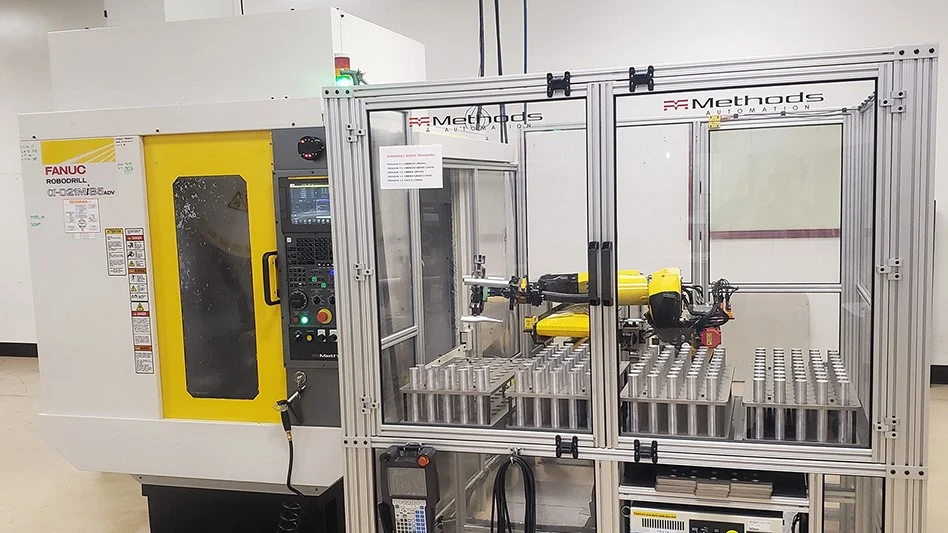
Methods Machine Tools

https://www.methodsmachine.com
The operations group at Ultradent Products Inc., a leading developer and manufacturer of high-tech dental materials and devices sought to increase production of its Valo curing light, used by dental clinicians to cure dental composites, sealants, and various other chemistries.
Valo curing lights are complex pieces of equipment, requiring numerous holes, finishes, and various geometries. In 2017, Ultradent required 45 minutes and three complex machining operations to produce one curing light housing.
Its original manufacturing process involved hand-loading raw materials and finished parts; a cumbersome process for a company with only three employees on the shop floor per shift. The manufacturing setup resulted in the occasional spindle crash, hindering operations and output.
“We needed more reliability and faster cycle times,” says Ryan Umpleby, Sr. CAD/CAM programmer at Ultradent.
Additionally, the company occasionally had to subcontract to other machine shops to meet rising demand, resulting in additional cost and Ultradent still had to perform additional operations to remove imperfections left by the subcontractor.
“We never end up fully outsourcing the part because their costs are too high, or they can’t match our quality,” Umpleby adds.
Realizing the need to reduce the part’s cycle time while increasing repeatability, Ultradent reached out to Methods Machine Tools’ sales engineer David Snow. After exchanging project requirements, the decision was to move forward with two custom automation cells, each comprising of an advanced RoboDrill, a FANUC robotic arm, and raw stock storage. Methods designed the system to hold 60 blanks – uniform pieces of raw material ready for machining.

https://www.methodsmachine.com
Embracing automation
At first, implementing a custom automation cell was a hard sell. Not everyone at Ultradent believed a smaller machine could outperform a larger horizontal machining center, one of the other options the company was considering.
“This small RoboDrill with a robot arm was a little intimidating,” Umpleby says. “It’s smaller than a horizontal, it’s automated, and it’s got a robot.”
“Anytime you introduce something new, people can be hesitant,” adds Kevin Marett, an engineering manager at Ultradent.
There was also some concern about possible steep learning curve associated with robotics and automation. Umpleby was tasked with programming the first automation cell and being relatively new to CNC machining at that time, he accessed Methods’ support network of experts – application, automation integration, installation – who helped him get the cell up and running.
“That was kind of an intimating task for me,” Umpleby says. “Between the help of a couple key people at Ultradent and all the support I needed from Methods, we were able to pull together a fantastic automated machining cell.”
The cell provided actionable data points, precise results, and reduced cycle time for a curing light housing more than half – 45 minutes to a 21-minute average. With only three employees on the shop floor per shift, automating the cumbersome process of loading/unloading material significantly improved the workflow.

https://www.methodsmachine.com
Support on speed dial
With 24/7 operations underway, Ultradent increased its throughput almost threefold while reducing machining costs associated with third-party processing.
While the second RoboDrill automation cell was getting the job done on time and under budget, Ultradent needed to expand the system, so they worked with Methods on designing a larger, third cell that boosted the blank capacity from 60 to 200.
Within a few weeks, Umpleby says they had a working concept, and after executing the idea, the company could automate an entire production run of 200 curing light housings.
“That was a pretty cool milestone for me, to see Methods pull through that quickly on such a huge change to the cell,” he adds.
Soon after, Methods added a fourth 200-capacity automation cell, bringing their total to four RoboDrills and four robotic components.

https://www.methodsmachine.com
Repeatability in action
The cells run unattended for 16 hours a day and lights-out on the weekends. In addition to increased throughput and machine uptime, the company has gained the desired repeatability thanks to the RoboDrill's rigid construction and precision.
Since implementing the RoboDrill and automation cell, Ultradent's quality assurance team has noticed a significant improvement in the machining accuracy of the curing light housing with perfectly threaded, 12mm blind holes.
“As we go through inspection data for thousands of units, we find that features don’t move within a half a thousandth of an inch. Part of that is tooling, part of that is how the tooling is held and how the machine is built so it’ll repeat from position to position,” Marett says.
Using automation to achieve growth
Ultradent did more than just increase throughput machine uptime and improve repeatability – they captured more market share.
During the most tumultuous period of the COVID-19 pandemic, the automation cell, combined with Ultradent’s ability to secure raw materials, allowed the company to continue machining. This enabled the company to capture additional market share while competitors lost production time to sick leave or suspended operations.
“We’ve almost doubled our capacity since we came out of COVID, and we couldn’t have done that without our third and fourth RoboDrill cells for sure,” Marett concludes.
Latest from Today's Medical Developments
- The toolbelt generation
- Covestro's role in transforming cardiac care
- Practical and Affordable Factory Digital Twins for SMEs
- UCIMU: fourth quarter 2024 machine tool orders on the rise
- Thomson Industries’ enhanced configuration capabilities
- Frequently Asked Questions about AM Post Processing
- How new executive orders may affect US FDA medical device operations
- Midwest DISCOVER MORE WITH MAZAK





